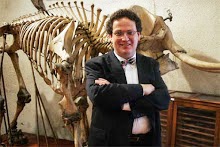MORPHOLOGY STILL KICKING
Much of the literature over the past couple of decades could give the reader the impression that whenever conflict exists in cladistic patterns indicated by DNA and morphology, DNA is to be assumed correct. After all, morphology is so complicated, variable, subjective, and old-fashioned. And it requires learning so many polysyllabic Classic-rooted terms, comparing hundreds or thousands of specimens, often making pain-staking dissections or preparations, and thinking... oh, so much thinking. Afterall, as Platnick's classic 1979 "transformation" paper detailed morphological data, unlike DNA, cannot simply be described (as A, C, T, or G) but requires formulation of explicit and falsifiable hypotheses about homology and polarity. Complexity, as it turns out, is the stuff of historical signal: the more complex the structure the more stringently Occam's razor and Dollo's principle apply. Simple = little or no historical information content. The greater the complexity of the charcter, the greater the potential for cladistic signal. Carefully developed concepts of characters have the curious property of lacking variation (they are classic examples of Popper's all-or-nothing claims about the world) and the notorious variation in morphology actually results from a confusion between informative systematic characters and infra-specific (or intra-clade) traits. Failure to think deeply and carefully assess informative vs uninformative or to loose sight of the distinction between info relevant to population genetics rather than taxonomy results in bewildering variation. No kidding. Morphological characters are no more subjective than assumptions about various models and rates of molecular change. And as for old, don't get me started. Morphology and the DNA coding it are — ready? drum roll, please — the same age. And if old just means morphology has been studied longer, then it is all for the good. Thinking about complicated and interesting questions for a long time is and will always remain advisable.
Enough rant. If you have not yet seen Gauthier et al's paper (title page above) or the discussion of it by Losos et al. in 12 December 2012 issue of Science (p. 1428) run, don't walk, to your library (or online subscription). I was excited by Gary Nelson's chapter in Milestones in Systematics in 2004 (edited by David Williams and Peter Forey) on the arrested development of cladistics in part because it called for returned focus on individual characters rather than an unhealthy, disproportionate focus on "tree" construction. If Dr. Nelson's paper was the shot heard 'round the world to reawaken a revolution begun by Hennig, then Gauthier et al.'s paper may be the first full-scale engagement in a long-overdue battle to recall why we studied phylogeny to begin with. It was and is to understand the origin and evolution of all the complex and wonderfully improbable evolutionary novelties that make biodiversity, well, diverse. Unless we study the complex characters of morphology (and behavior and developmental genetics and...) themselves, then we lose sight of what is most interesting about pursuing cladograms, and we deprive ourselves of many of the most intellectually challenging and gratifying aspects of comparative biology. And considering that 10,000,000 of an estimated 12,000,000 living species of plants and animals with complex morphologies (apologies to microbes with fascinating complex characters, of which there are many) remain unknown to science, a return to exploring the Cosmos of anatomical diversity is essential if we are to progress beyond arguing over cladograms for the fraction of already known homologies and species. Given recent advances in digitization and a potential on the horizon for comparing any specimen from any museum side-by-side at any time, the number of morphological apomorphies about to be discovered will be mind-boggling. Morphologists are on the threshold of waging shock-and-awe warfare as details of the evolution of life on earth is revealed. Lock and load.



